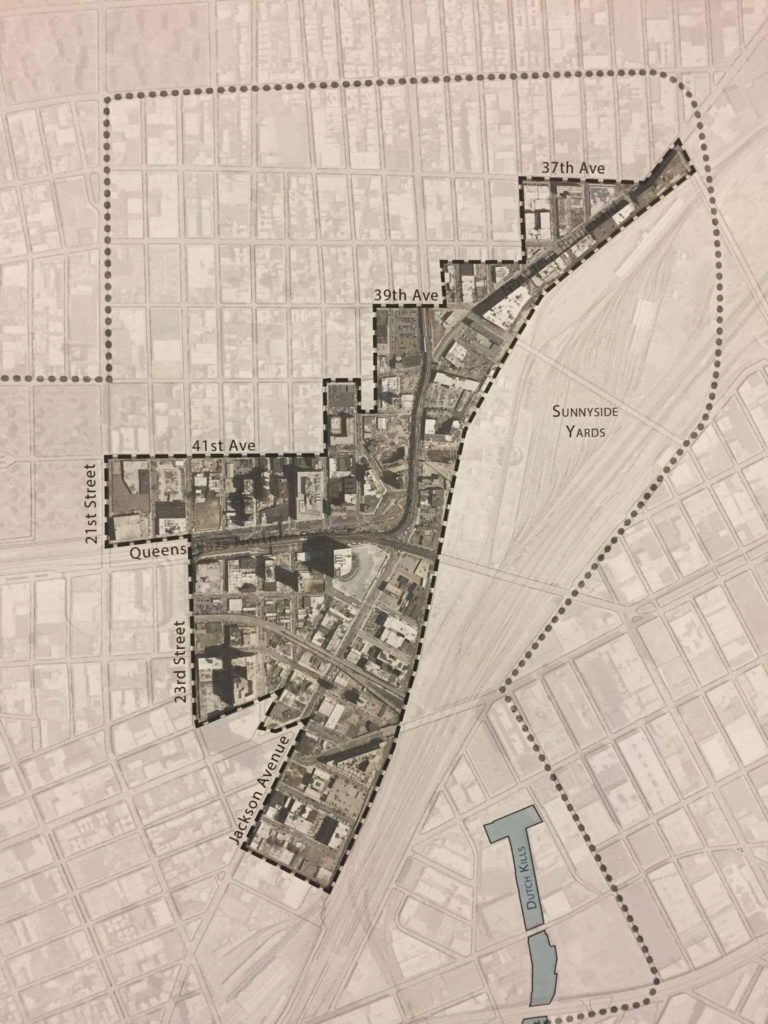A plan to rezone parts of Long Island City to encourage mixed-use development has many longtime neighborhood residents extremely concerned.
The Department of City Planning (DCP) on Tuesday presented the Long Island City Core Neighborhood Planning Study in an auditorium at CUNY Law School. The neighborhood is one of 15 that Mayor Bill de Blasio has announced he wants to upzone to build and preserve more affordable housing as part of his Housing New York plan.
The area identified for the rezoning is a slice of the Court Square, Queens Plaza and Dutch Kills neighborhoods that have seen explosive development in recent years. Queens Plaza was rezoned in 2001 by DCP in the hopes that more office space would be built. Instead, 13,000 units of housing went up or are in the process of being built, and only 5 percent or 650 units are affordable.

About 2 million square feet of office space was constructed or is in the process of being constructed, but the city was hoping to get closer to 6 million square feet, according to Senior Planner Penny Lee.
“We really want to take a look at the development patterns going on, figure out how to re-establish a balance of uses here and then figure out how we can increase the percentage of affordable units,” she said.
Many of those in the audience, who have lived in the neighborhoods for decades or are business owners, expressed frustration with rising rents and argued that this rezoning would only drive prices up.
Jenny Dubnau, an artist with studio space in Dutch Kills, said her rent has increasingly become unaffordable.
“I’m very worried and there’s nothing in this plan that calms me because there are dozens and dozens of hotels, dozens of luxury high-rise buildings and even if you go to the deeper affordability in what we all know are luxury buildings the deeper affordability you get, the smaller the percentage,” she said. “So you get crumbs of possible affordability but then you have 80 percent that are luxury.”
Dubnau said her landlord raised her art studio rent by 50 percent and argued that the market had changed because of the luxury apartments and new hotels going up in the area.
“You’re going to get some strong pushback from me and a lot of other people unless we see that the building and development being done is for us so that we can stay here,” she said.
Lee argued that the lack of office space in the neighborhood is causing landlords who own the small portion of office or industrial space to raise rent and that this plan would “relieve pressure” and lower rents.
“Zoning right now only allows market-rate housing,” she said. “So we can do nothing and allow development to continue as it is and not get any affordable and not try and encourage office space to relieve pressure, or we can do a study like this and look at ways of applying an affordable housing requirement and look at ways to encourage office development so we can get a more equitable neighborhood.”
Residents who live in NYCHA housing, including Ravenswood and Queensbridge Houses, also want to know how they will be included in the plan.
“They’re doubling my rent because they’re saying it’s the new median they have to go by,” said a 55-year-old Ravenswood resident. “I can’t afford public housing? That’s ridiculous. Y’all have to work with the people who are already here.”
Mary McClary, a member of the Justice for All Coalition and Ravenswood Houses resident, said she wants to know how NYCHA “fits into the change that’s going on around us.”
“The main thing that well be trying to do with Queensbridge and certainly at Ravenswood is work with our partners at Small Business Services to talk about training and economic opportunities,” said John Young, director of the Queens borough office. “We want to make sure that as this area really has the opportunity to really fulfill new business opportunities, grow as this mixed-use center. We want to make sure that there’s the training for the type of jobs we expect to be here so that then these residents will have the opportunity to be able to apply and be considered for these jobs.”
Rebecca Olinger, who has lived in Long Island City for 21 years, said the neighborhood has a dearth of useful retail like drugstores and that much of the retail is concentrated along the waterfront or in luxury high-rise buildings.
“My concern is the retail for the rest of us who do not live in these high-rises,” she said. “The businesses we get our expensive grocery stores, all the amenities that are needed in a neighborhood we are not getting. There is a tremendous amount of us now that do not live on the waterfront. When I moved to this neighborhood we had hardware stores, we had a butcher.”
Lee argued that the neighborhood does not have the daytime population needed to sustain those types of businesses yet.
The meeting got heated at one point when New York City resident Ann McDermott argued that the mayor was bought by the real estate industry. She also added that the city was not clearly enforcing rent stabilization laws.
“We have a mayor who is totally in the pocket of the real estate industry and gave the City Council a 36 percent raise to pass MIH,” McDermott said to applause. “But it seems like you want to get rid of everybody who’s been here and kept this place alive. Were tired of this. We are totally tired of these presentations and the bullshit you are feeding us. The people of New York City are going to rise up against the f**king real estate industry and were going to stop you from destroying our city.”
Almost every community board in Queens and the rest of the city voted against two zoning amendments presented by the mayor in 2015. Mandatory Inclusionary Housing would require a portion of new housing to be permanently affordable in certain areas that are rezoned.
The Zoning for Quality and Affordability text amendment focuses on providing affordable senior housing and care facilities, enabling mixed-income housing and changes rules to encourage developers to move away from “flat, dull apartment buildings,” and toward the inclusion of retail space and greenery.
City Council voted to approve the amendments a few months after they received a 36 percent pay raise despite the heavy opposition from community groups.
A portion of Flushing was also included in the mayor’s rezoning plans, but after opposition from community members and Councilman Peter Koo, the plans were scrapped.
DCP will continue to hold meetings with residents and community stakeholders about Long Island City’s rezoning until June. To send any questions or comments to DCP about the study, email liccore@planning.nyc.gov.



































